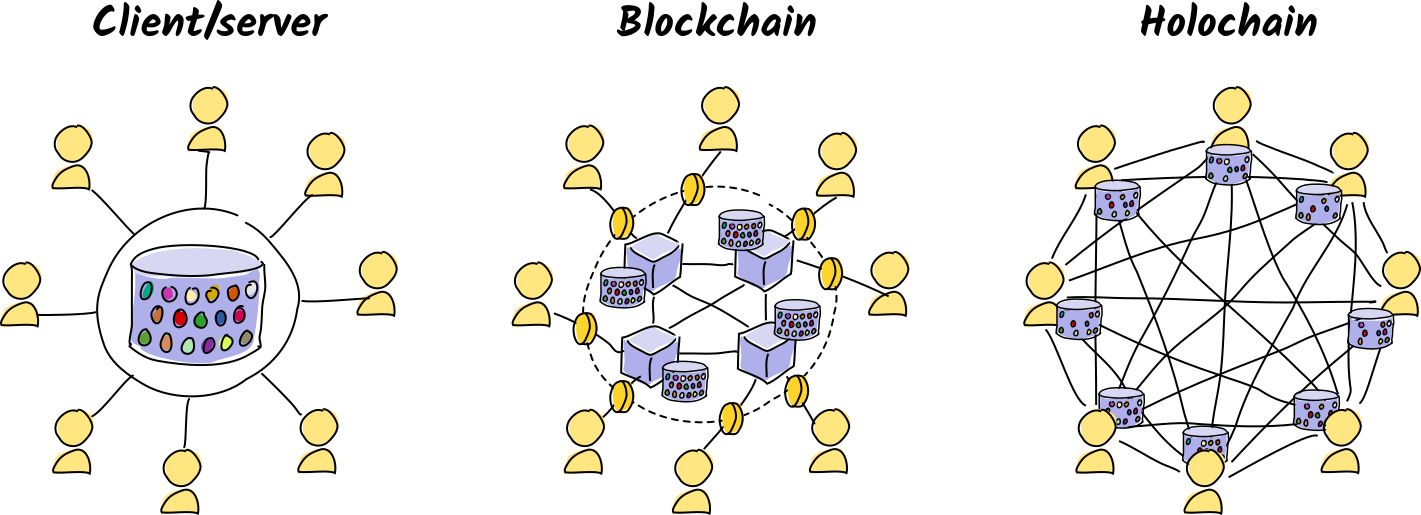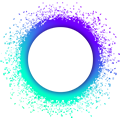Holochain Core Concepts: What is Holochain?
Holochain is an open-source application development framework and peer-to-peer networking protocol. It allows you to create actually serverless applications with high levels of security, reliability, and performance. Every participant runs the application on their own device, creates and stores their own data, and talks directly to other participants. The security of the application is supported by both cryptography and peer accountability.
What you’ll learn
Why it matters
You’ll understand how Holochain is different from centralized architectures, and how this difference can make your applications more robust, secure, and affordable.

The problem with centralized architectures
We’re all familiar with the client/server architecture. It’s comfortable, allows for easy maintenance, and is well supported by a marketplace of service providers. It also makes it easy for you to control access rights and enforce business rules. As a focal point for processing and storage, however, it leaves your application vulnerable:
- It’s an attractive target for hackers.
- Device and network outages or misconfiguration can take the app down.
- Hosting costs scale with traffic, making you a victim of your own success.
- Storing private user data increases your legal and moral liability.
Current solutions
Cloud hosting platforms offer horizontal scaling. As your application grows, you add more virtual machines to increase availability. This requires you to maintain a fleet of servers, with all the responsibilities that go along with that.
Serverless computing liberates you from those details and lets you focus on the core of your application — just choose the ingredients, link them together with functions, and press play. However, it is just an abstraction; it still runs on rented hardware with recurring costs and central failure points.
Distributed computing efforts, like blockchain, attempt to solve these problems by creating a network of participants who all hold identical copies of a public, global data set. Each participant helps maintain the availability and integrity of the data. Centralized vulnerabilities are eliminated. However, it’s costly to replicate, check, and come to consensus on the contents of the data set, usually by design. This hurts performance and creates waste. It also leads to centralization — participants are separated into ‘full nodes’ who have the computer power, reputation, or capital to participate, and ‘light clients’ who have to ask the full nodes to do things for them, often in exchange for fees. To our thinking, this begins to sound like client/server all over again.
How Holochain does things differently
Holochain approaches the problem from a different starting point. Rather than assume that a unified, consistent system state is always needed, it simply lets each player in the system maintain its own state, make that state available to others, and access others’ states. This is sufficient for most things we do online. Daily life offers a great demonstration of this — we interact with each other just fine without an absolute, ordered, total view of everything everyone’s done, and only spend effort reaching consensus when it’s absolutely necessary.
Holochain starts with users, not servers or data, as the primary system component. The application is modeled from the user perspective, which we call agent-centric computing. Equipped with the Holochain runtime, each user runs their own copy of the back-end code, controls their identity, and stores their own private and public data. An encrypted peer-to-peer network for each app means that users can find each other and communicate information among each other.
Then we ask what sort of data integrity guarantees people need in order to interact meaningfully and safely with the data they receive from others. Half of the problem is already solved — when you have the ‘rules of the game’ on your machine, you can verify that your peers are playing the game correctly just by validating their data they create. On top of this, we add cryptography to prove authorship and detect third-party tampering.
This is Holochain’s first pillar: intrinsic data validity.
However, we’re only halfway there. It’s not particularly resilient; data can get lost when people go offline. It can also place an undue burden on honest participants if they have to validate every single piece of data they want to consume.
So we add another pillar: peer witnessing. Each piece of public data is witnessed, validated, and stored by a random selection of devices. Together, all cooperating participants detect invalid data, share evidence of corrupt actors or validators, and take steps to counteract threats. Most of the work is done before you even retrieve the piece of data you want.
These simple building blocks create something surprisingly robust and scalable — a multicellular social organism with a memory and an immune system. It mimics the way that biological systems have managed to thrive and grow in the face of novel threats for millions of years.
While the foundation of Holochain is simple, the consequences of its design can lead to new challenges. But most of the solutions can be found in the experiences of real life, which is already agent-centric. Additionally, some of the trickier problems of distributed computing are handled by Holochain itself at the ‘subconscious’ layer. Your main focus as an application creator is your data model and your business logic.
Key takeaways
- Traditional centralized architectures are easy to understand, maintain, and secure, but they create central points of failure.
- Holochain turns the architecture of applications inside-out — users are at the center of their online presence, in charge of their own identity, data, and processing.
- In a Holochain app, processing, storage, and security risk are distributed across the entire network. This reduces central points of failure, bottlenecks, and attractive attack targets.
- The two pillars of application integrity are intrinsic data integrity and peer validation.
- There is no single global database for application state; data comes from many individual sources.
- Each user of an app also participates in building the app’s infrastructure, supplying their own compute and storage resources and taking responsibility for validating and storing a small portion of other users’ data.
- The whole is greater than the sum of its parts — many agents, playing by simple rules, combine to form a social organism that maintains its own health.

